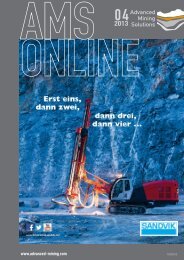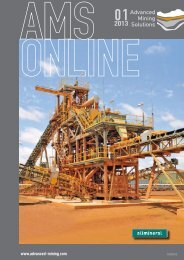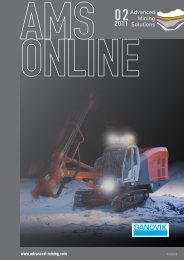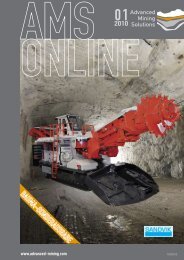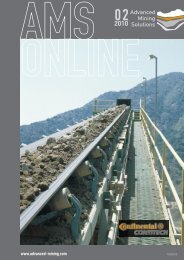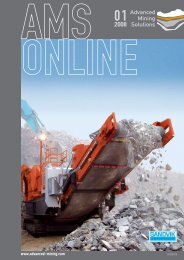A new face drilling rig for narrow tunnels and ... - Advanced Mining
A new face drilling rig for narrow tunnels and ... - Advanced Mining
A new face drilling rig for narrow tunnels and ... - Advanced Mining
You also want an ePaper? Increase the reach of your titles
YUMPU automatically turns print PDFs into web optimized ePapers that Google loves.
Sound power P<br />
Sound power P is the acoustic power that is delivered<br />
by a vibrating element as airborne sound. It is expressed in<br />
Nm/s or W. The sound power is, by analogy to the power<br />
known in the physics, a relative quantity that is not able to<br />
be measured directly.<br />
The sound power P is an emission quantity of a plant,<br />
a machine or a component. It can only be indirectly<br />
determined by measuring a field size. To analyze the sound<br />
power, there are available the sound ranging methods.<br />
The sound ranging can take place in a dead room, in a<br />
free field or in a live room while taking into account the<br />
environmental conditions.<br />
Another possibility of sound ranging is the metering<br />
of the sound intensity on a measuring sur<strong>face</strong> round the<br />
object while eliminating the environmental influences to a<br />
certain degree.<br />
The mathematical link between sound pressure, sound<br />
intensity <strong>and</strong> sound power is described following the<br />
definitions speed of sound, sound particle velocity <strong>and</strong><br />
their effective values.<br />
Link between sound pressure <strong>and</strong> sound<br />
power<br />
The link between sound pressure <strong>and</strong> sound power is the<br />
most important base to be able to underst<strong>and</strong> acoustics.<br />
The sound power is not directly measurable, as already<br />
mentioned be<strong>for</strong>e, but it is to be fixed by measuring the<br />
sound pressure. While doing so, there is to be indicated,<br />
Issue 04 | 2010<br />
TRANSFER OF TECHNOLOGY<br />
Fig. 2:<br />
Überlagerung Schalldruck und<br />
Atmosphärnedruck<br />
among the pressure, the measuring point as well (distance<br />
from source).<br />
This shows the often cited analogy to the thermal<br />
output of a source that is not directly measurable. Through<br />
measurement of temperature at a place in a defined position<br />
towards the source it is enabled the thermal output of a<br />
body to be determined.<br />
It is of importance to be always aware of the conditions<br />
<strong>for</strong> the validity of the link, derived in the following. We<br />
are working on the assumption that it is a homogeneous<br />
source, isotropically radiating in an otherwise isotropic<br />
room. Both conditions are only fulfilled in special cases.<br />
The error resulting from the condition fixed by our end,<br />
however, is negligible as long as we only need a „good<br />
estimation“. All further reflections on this topic are further<br />
based on the incoherence of the sources.<br />
Speed of sound or sound velocity c<br />
Speed of sound or sound velocity c is the speed at<br />
which the sound waves propagate. It is to set apart from<br />
the sound particle velocity. By way of illustration, the wave<br />
motion is represented in figure 1.01. Each point may be<br />
a gas molecule (air particle). The particle itself effects<br />
a harmonic vibration round its neutral position (vertical<br />
lines A – M). Due to excursion neighbouring particles get<br />
expelled from their neutral position, <strong>and</strong> they also effect,<br />
to the neighbouring particle, a phase-shifted, harmonic<br />
vibration round this neutral position. That is how the wave<br />
propagation (blue line) is created. The gradient of the<br />
straight line is a measure <strong>for</strong> the sound velocity.<br />
www.advanced-mining.com<br />
69



